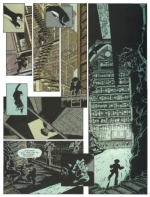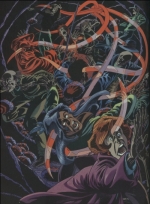| Rork.nl - Articles | | Home | Articles | Downloads | Contact | | ||||
|
The art of Capricorne
Capricorne is a comic written by Andreas who also wrote Rork, Cromwell Stone, Arq and some other comics. The reason I like the comic is because Andreas uses many techniques in drawing, lay-out and story telling to make the comic part more then just a series of pictures which show what happens.
The first thing you'll notice when opening a Capricorne album is the general lay-out of the page, as opposed to most other European comics you won't find the normal even sized rows and rectangles, instead Andreas makes the pictures as big as he wants, without borders, placing other pictures inside them or overlapping other pictures. This makes the pages more dynamic and the overlapping pictures make the lower picture feel bigger then it actually shows, conversations and actions are also scaled for functionality. A nice use of scale is the note that reaches Manga in album 3, the hands which pass the note start small and when the note reaches its destination the picture grows bigger and bigger, now it's not just six passes shown in the album, it seems to be much more then that.
But there's more then that to it, Andreas often uses the continuity principle where pictures overlap so the eye follows the action, for example when Astor persuits his cat into the older parts of the library where he finds the phantom book. You can see Astor climb down while the cat is jumping through the page. Another nice example where he doesn't use overlapping pictures is in album 2: Capricorne follows the electrical wiring to the core: he starts at the lamp, and you can follow the wiring behind the wall, grouped and through larger tubes.
Something Anreas uses far less is a nice transition in scenes. In the first album after the bookstore has been burned down we see Astor mourn about it with a book in his hands. When you look at his glasses you will see the flames which are comming out of the airship as a reflection and Astors growing worries about it.
But despite all the techniques Andreas uses what would a comic drawer be if he couldn't draw a good picture, throughout the series he shows his skills in drawing cities, laboratories, actions and all sort of things, some are quite plain but all reach a certain level of detail. But sometimes you'll find an extraordinary image, for example the picture where the "phenomenon" hits the group digging for the Concept control center.
If you want to know more about Andreas' art have a look at the images and articles at Dossier Andreas. The article ‘Andreas et la mis an page: Decente’ explain more about his drawings and the continuity principle. Also Andreas and Rork. Not just any strip... No, a graphic masterpiece (Dutch only) is an interesting article where Andreas explains his stories and drawings. |
|||||



